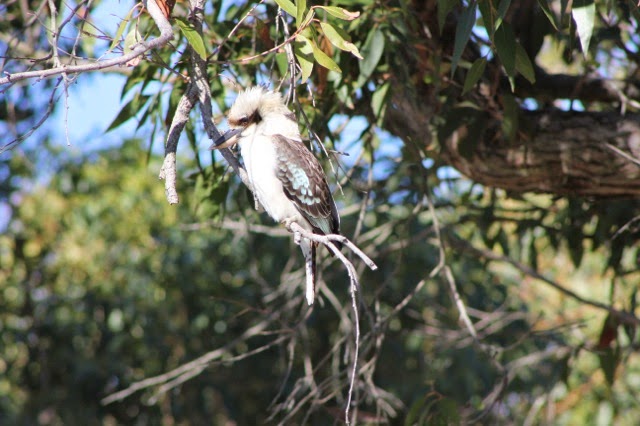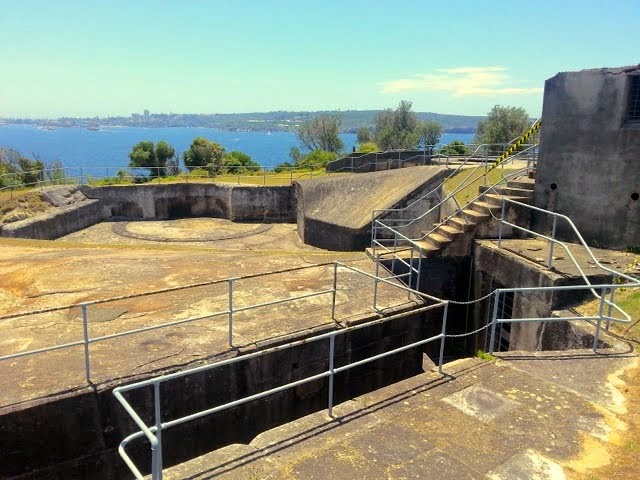Sydney Harbour Walk - What a View!
Any walk along the Sydney Harbour foreshore which starts with a ferry ride is guaranteed to lighten your step, if not your backpack if you weaken to the lure of that energy providing chocolate bar which you plan to munch mid journey. Catch the ferry at Circular Quay with unsurpassed views of the Opera House, the mighty Harbour Bridge, the Prime Minister’s exquisite Sydney residence (for Americans, think “Cramp” David with a view), and the tiny island with its 19th Century, Fort Denison Martello Tower, on your way to the landing at the Zoo with a View, Taronga Park, and it is almost reward enough.

The entrance to Sydney Harbour between the North and South Heads

Harbour views - you can just see the Opera House
We three walkers, with a superb map of our journey by the Sharing Sydney Harbour organisation are taking the “easy 10 kilometre” green mantled trail, which hugs the harbour between Taronga Zoo and Balmoral Beach. In many places there is a man-made, slightly raised walkway, which makes striding for the supple and those with legs that are “simply serviceable,” a piece of cake. Plenty of time for dappled views across to the city-scape with a foreground of yachts, boats and at times, majestic cruise ships which have come calling. Plenty of time too for spotting cheeky little water dragon lizards, raising themselves as though doing push-ups and then snaking off into the undergrowth. Catch a kookaburra or bandicoot, but sorry, no kangaroos.

Kookaburra sits in the old gum tree - merry merry king of the bush is he!
First stop is Bradley’s Head with its small lighthouse (1905) and the much taller “Fighting Mast” of the HMAS (His Majesty’s Australian Ship) Sydney, which in November 1914, fought and defeated the German Light Cruiser, Emden. The German captain ran his ship aground in the Keeling island after it was severely damaged by gunnery, giving the newly emerged nation of Australia, its first naval victory. The Sydney was scrapped in 1929 and it’s mast symbolises that victory. “Emden Beached and Done For” was the famous signal sent to Naval Headquarters. The battle became renown for the magnanimity of the victors in helping rescue many wounded Germans and taking them to hospitals in Sri Lanka and the pluck of a group of Germans who stole a schooner and eventually got home. There are also numerous other plaques to Australian ships involved in other battles and incidents as well as a lovely little amphitheatre for plays and dance, or just enjoying the cross water views, particularly the famous New Year’s fireworks all over the harbour. The area was also the site of background scenes from the Tom Cruise mega-flick, Mission Impossible II.

The walking track to Bradley's Head on the Harbour foreshore

The "Fighting Mast" of the HMAS SYDNEY which in WWI caught and sank the German cruiser, Emden
There is too, standing on a rock in the water, a Doric Column in need of something nautical atop. Perhaps, a Nelson, but then he got a better offer in London’s Trafalgar Square, although wheeling seagulls might be lesser ‘daily depositors’ than a million pigeons - and a breeze comes with the view. I know what I would prefer! The column is in fact one of six from the long demolished Sydney Post Office, which have been curiously placed in some other “round the city” sites.

Yo, a plinth, Where did Nelson Go, maybe to Trafalgar Square, maybe there were more pigeons there!
The onward trail now leads north, skirting the serene and secluded Taylor’s Bay with its finger-nail beach, just the bush and the bay with occasionally a glimpse of the passing Manly ferries. We pass lots of hatted and capped “oldies” doing the walk in the other direction, small parties of tourists too, all with a friendly wave and a word. The trail is gravel or cut through the sandstone, with little wooden bridges over gullies, past the salubrious suburb of Clifton Gardens with its mansions amid the trees and big yachts at the bottom of the gardens.

Lush growth and the suburb of wealthy Clifton Gardens
There are a series of steps down into Chowder Bay, a safe swimming beach, once the private domain of the military and before that, a coal mine dug into an underwater seam. Most of the military buildings have been restored to their former glory, one into exclusive accommodation and another into Ripples, a ritzy restaurant. Nearby is the Institute of Marine Science and student dormitories. We found a hole-in-the-wall cafe for a fruit juice and some good double-shot lattes, sitting and watching the swimmers, before resuming the walk.

Chowder Bay, Clifton Gardens and the City backdrop

Formerly the Sergeant Major's cottage

Chowder Bay; Former Army base now handed back to the people
The next section to Middle Head follows the road through the bush canopy although for the daring, there is the “clothing optional” Obelisk Beach, although the parking meters are obligatory fare! The Sydney Harbour National Park continues with the Georges Head forts, and the Inner and Outer Middle Head ones, the earliest dating from 1801. There was a construction spurt during the Crimean War (1854) and with the establishment of the School of Artillery in 1885, till it was moved to South Head in 1894. Prior to WWI the circular gun sites were built, modernised and extended further during WWII, when in 1942, the batteries were involved in the conflict with three Japanese midget submarines which entered the harbour.

C19th Fortifications on Middle Head
During the Vietnam War the extensive tunnels under Middle Head often flooded and “so provided the perfect place to familiarise Vietnam bound officers in torture (Which might happen at the hands of the Vietnamese!)” the infamous Tiger cages. The whole area is well maintained by the Sydney Harbour National Park Trust with tours, led by volunteers, of the Georges Heights facilities. It too has a gun in place “to give realism to the site,” never mind that it is a naval gun taken from a ship. Most of the guns went to scrap or to static display at Returned Servicemen’s Clubs around New South Wales. There is a convenient cafe - Frenchies - to slake the thirst and feed the walker or the visitor, for there is enough to see and explore as the area was an Officer convalescence centre after WWI. Unfortunately, the signage and facilities/explanation are rather poor at the Inner and Outer forts, unlike similar structures in the US and Europe.

Tunnels to the guns

Gun at George's Head fort

Gun at George's Head fort - 6" battery gun

Old Muzzle-loading gun 'carriages'

Fort "upgraded" for WWII use - guns long gone silent and made into scrap.

Georgian cannon at George's Heights with the Manly ferry in its sights

Replica WWII shells in the magazine
We passed the stylish restaurant and upmarket bric-a-brac store Burnt Orange, full of lunchers, past the HMAS Penguin Naval Establishment, still an active Fleet Command centre with the diving and hydrological commands, and houses the Naval Hospital, then down scores of steps through thick bushland, to emerge at the lovely Balmoral beach. (Thank goodness we didn’t have to trek up the steps! It was the heart of the school holidays, the sun shining, the water cool and inviting, and I recalled the lines from W.H. Davies poem I read as a boy, Girls scream! Boys shout! Dog’s bark! School’s out!
Fish and chips were in the air, bathers and sunners, everywhere. An ice-cream was obligatory. I secretly hoped for the bus back to the zoo and the ferry ride home, but the bus through the ‘burbs came first, and with the beach-towel brigade boarding, we did too for the journey back to central Sydney, to go our separate ways. For me there was still a train home, elated and spiritually sated.

Balmoral Beach (From North Head)
Winfred Peppinck is the Tales of the Traveling Editor for Wandering Educators
All photos courtesy and copyright Winfred Peppinck





















